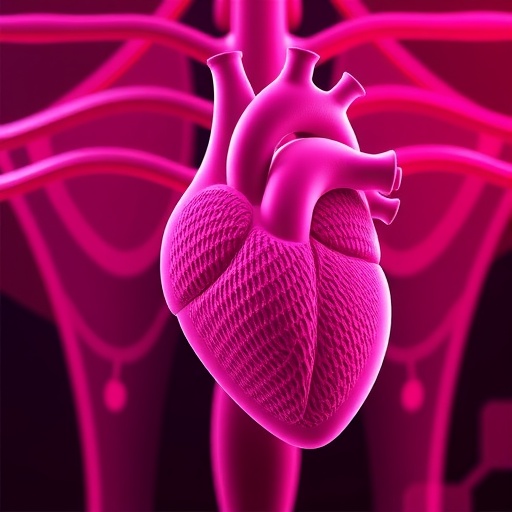A groundbreaking study has opened a window into the complex interplay of gender and cardiovascular health, specifically focusing on aortic valve stenosis (AS). This condition, characterized by the narrowing of the aortic valve, has often been treated without a comprehensive understanding of how it affects men and women differently. The research, spearheaded by a team of scientists led by Dr. Anabela Grego, has utilized cutting-edge proteomics techniques to unearth significant findings regarding sexual dimorphism in AS. These revelations not only challenge established medical paradigms but also pave the way for more personalized treatment approaches.
Historically, aortic valve stenosis has been viewed predominantly through a male lens, potentially skewing diagnosis and treatment for women. The implications of this oversight are profound; data suggests that women are frequently underdiagnosed or undertreated for AS despite their experiences of symptoms. The current study aims to provide clarity in this regard by investigating the heterogeneous biological mechanisms at play in both sexes. Utilizing proteomic analysis, the researchers dissect the molecular profiles associated with AS, thereby revealing discrepancies that could lead to sex-specific manifestations of the disease.
Proteomics, the large-scale study of proteins, serves as a crucial tool in understanding the pathophysiology of aortic stenosis. By employing advanced profiling techniques, the researchers isolated and characterized proteins from cardiac tissues of male and female patients suffering from AS. The results indicated a marked difference in the protein expression levels between the sexes, highlighting distinct molecular pathways influenced by gender. These findings serve as a stark reminder of the biological differences that exist, influencing disease progression and response to treatment.
The team discovered that inflammatory biomarkers differed significantly between male and female patients with AS. This observation is critical because chronic inflammation is known to contribute to valve degeneration. The variations identified suggest that men may exhibit a more pronounced inflammatory response compared to women, which could explain why men are often diagnosed earlier and with more severe forms of AS. Conversely, women may experience a more gradual progression of the disease, resulting in misdiagnosis or a delay in seeking treatment.
Moreover, the investigation uncovered alterations in extracellular matrix composition between sexes in relation to AS. This aspect is particularly intriguing, as the extracellular matrix plays a critical role in maintaining the structural integrity of the heart valves. The findings suggest that sex-specific differences in the extracellular matrix may affect how the aortic valve responds to stress, potentially leading to distinct clinical features in men and women suffering from AS.
Perhaps one of the most compelling findings of the study revolves around hormonal influences on the pathogenesis of AS. Investigators noted that estrogen levels might have a protective effect against the progression of aortic stenosis in women. This aligns with previous research indicating that premenopausal women tend to have a lower incidence of cardiovascular diseases in general. The number of differences identified corroborates the need for considering sex as a biological variable in the study and treatment of AS, reaffirming calls for a more nuanced understanding of how gender impacts health outcomes.
The implications of these findings touch on multiple levels, from clinical practice to broader healthcare policies. If proteomic profiling can establish specific biomarkers that indicate variability in disease progression between sexes, screenings can be tailored accordingly. This could lead to earlier intervention strategies designed specifically for women, potentially averting the severe consequences often associated with AS. Furthermore, it may encourage a reevaluation of current guidelines that do not adequately distinguish between male and female presentations of the disease.
Additionally, this research opens avenues for improved patient-centered approaches in the treatment of aortic stenosis. As clinicians become more aware of the biological differences highlighted by this investigation, they may be more inclined to personalize treatment plans. Such an approach could enhance therapeutic efficacy and address previously overlooked health disparities between genders, ultimately leading to better health outcomes for all AS patients.
Future research inspired by these findings could focus on further elucidating the molecular mechanisms tied to gender-specific responses to cardiovascular diseases. The necessity for more balanced representation in clinical studies is clear—gender disparities in biomedical research have historically led to gaps in knowledge and unequal treatment outcomes. By spotlighting these differences, researchers like Dr. Grego and her team hope to encourage a cultural shift within the scientific community toward equitable and comprehensive health research.
In summary, this pioneering study reexamines aortic valve stenosis through a transformative lens, unveiling the critical importance of considering sex differences in understanding and treating cardiovascular diseases. With proteomics paving the way for revelations about the differential biology of AS, the healthcare sphere stands at the threshold of a new era in precision medicine. The need to prioritize gender-specific research initiatives is not just a call to action; it is an imperative part of optimizing patient care and improving cardiovascular health outcomes across populations.
As we stand on the cusp of advancing medical understanding and treatment efficacy, integrating these sex-based insights into clinical protocols represents a significant leap forward. The work by Dr. Grego and her colleagues signifies not only a scientific triumph but also a hopeful pivot towards a future where every patient’s unique biological makeup is honored in the pursuit of optimal health.
Subject of Research: Sexual Dimorphism in Aortic Valve Stenosis
Article Title: Dissecting sexual dimorphism in aortic valve stenosis by proteomics
Article References:
Grego, A., Sousa-Mendes, C., Martins, D. et al. Dissecting sexual dimorphism in aortic valve stenosis by proteomics.
Clin Proteom 22, 34 (2025). https://doi.org/10.1186/s12014-025-09549-1
Image Credits: AI Generated
DOI: https://doi.org/10.1186/s12014-025-09549-1
Keywords: Aortic Valve Stenosis, Proteomics, Sexual Dimorphism, Gender Differences, Cardiovascular Health, Inflammation, Extracellular Matrix, Hormonal Influences.




